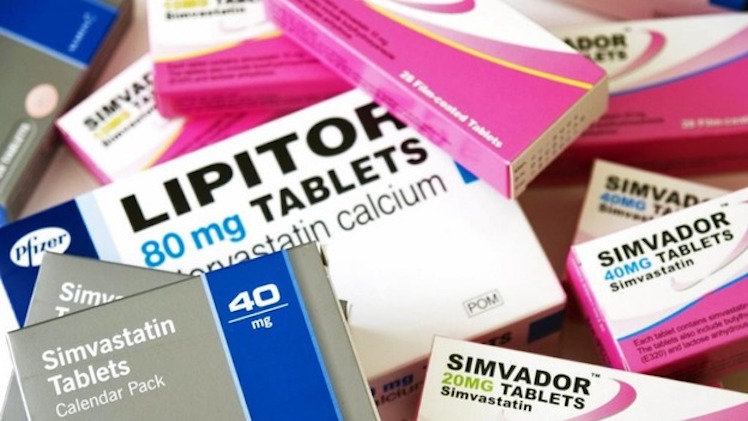Dr Maryanne Demasi Statin Wars Have We Been Misled About the Evidence? A Narrative Review

Science journalist Maryanne Demasi completes her two-office investigation into statins, one of the globe'southward most profitable drugs. We know statins work. What we don't know is information about their side furnishings. Many leading doctors now believe statins are being overprescribed but the raw information on statins remains concealed by the pharmaceutical companies who brand them, businesses which are heavily subsidised past taxpayers around the world. This 2-function series is the upshot of an important peer-reviewed article by Demasi. Information technology is Non medical communication.
Statin Wars Office two — Read Role 1 hither.
Take we been misled?
Yesterday, I reported on renewed calls for greater transparency from a growing number of doctors seeking access to undisclosed data on statin side furnishings.
These calls accept prompted fresh concerns well-nigh the actuality of the statin data and led to biting divisions within the medical fraternity.
Proponents describe statins equally one of "the most important advances in medical history and have prevented untold eye attacks and strokes". Detractors say statins "serve no purpose in lowering cholesterol to prevent cardiac bug" and even label them "unnecessary and toxic".
Early clinical trials suggested that statins should be express to people with advanced heart disease. Today withal, a vastly unlike discussion is afoot.
Some United kingdom experts propose that everyone over the age of 50 should be on a statin, even if they don't have high cholesterol. Others propose we offer statins as condiments in burger outlets to "cancel out" the effects of a fast-food meal. Some propose we screen kids for loftier cholesterol to identify statin recipients and there has even been give-and-take virtually putting statins in the water supply.
And then how did we go from prescribing statins to a select grouping of people to recommending them for children, adults and anyone who consumes drinking water?
In Part 2 of this investigation, I examine how statins came to exist one of the most widely prescribed drugs in the history of medicine.
My total peer-reviewed article on the subject was published in the British Journal of Sports Medicine yesterday, which you can read here.
The rise of a blockbuster drug
The price of developing a prescription drug to gain market approval now exceeds $US2.v billion. A more constructive way to fast-track company profits is to augment the utilise of an existing drug. In the case of statins, influencing medical prescribing guidelines is a convenient and powerful fashion to increase the use of a drug and drive higher profits.
When the US National Cholesterol Education Programme (NCEP) revised its definition of "loftier cholesterol" by dramatically lowering the threshold, it meant millions more people would become eligible for statins overnight. The decision was not based on any new scientific data but rather the increasingly pop notion that "lower is meliorate".
The move sparked a furore when it was revealed that viii out of nine members on the 2004 NCEP guideline commission had straight fiscal ties to statin manufacturers.
"eight out of ix members on the
2004 NCEP guideline committee had
direct fiscal ties to statin manufacturers"
Then, in 2013, the American College of Cardiologists (ACC) and the American Eye Association (AHA) changed their guidelines to reflect a person's "calculated run a risk". Again, it meant that millions more adults would be prescribed statins, almost of whom were older people without middle disease and for whom the prove for benefit was lacking.
Before long afterwards, the Great britain'south National Establish for Health and Care Excellence (N.I.C.Eastward) announced its plan to slash the "calculated hazard" threshold for prescribing statins by one-half. North.I.C.East'due south deciding console comprised 12 members, 8 of whom had fiscal ties to manufacturers of cholesterol-lowering drugs. UK doctors vigorously objected to the changes saying it was "non evidence-based" and could lead to the "medicalisation of healthy people at the price of more than needy, unwell patients".
In improver, the "risk calculators" which a doc uses to assess a patient'due south risk of heart affliction and determine whether or not to prescribe a statin, is likely to be inaccurate. A study examined five risk calculators and demonstrated that 4, including the new AHA-ACC-risk calculator, showed the over-estimation of risk could be equally high as 115 per cent, giving rising to concerns about the undisciplined over-prescription of statins.
This phenomenon is dubbed "diagnosis creep", a procedure which – by simply changing the definition of a disease or lowering the threshold of risk – healthy people are turned into patients overnight. Doctors are at present raising sensation to reduce the harms of over-diagnosing and over-medicating people, in a campaign called "Too Much Medicine", upon which I previously reported.
Conflicts of Interest
In the 1980s, when US President Ronald Reagan came into office and slashed government funding to the National Institutes of Wellness, it left a gaping pigsty for private industry to motility in.
Drug manufacturers sponsor the vast majority of statin trials. Notably, one major not-industry funded study on statins actually showed that the drug had no benefit in reducing death or coronary centre disease in healthy people. A recent Cochrane review showed that sponsorship of drug trials by the drug manufacturer leads to more favourable results and conclusions than sponsorship by other sources.

There is too business concern nigh the influential views of eminent doctors who are on the payroll of drug companies. These doctors might argue that "science is science" and that information technology doesn't thing who pays for it. Only others disagree.
"When drug industry sponsored trials cannot be examined and questioned by contained researchers, science ceases to be and it becomes nothing more than marketing", says Professor Peter Gøtzsche from the Nordic Cochrane Collaboration.

"Reputations and big money are at pale. Not only are financial conflicts of interest at play, just the behavior of many statin proponents exemplifies the concept of confirmation bias – seeing what yous want to run across and ignoring what yous exercise not", says US cardiologist Professor Robert DuBroff from the University of New Mexico.
Underplaying the risks
At that place are simple ways to design a clinical trial which has the consequence of minimising the harms of the drug. One example is the use of a "run-in" period, such as in the Heart Protection Written report. All participants took a statin for six weeks prior to the commencement of the trial, later on which fourth dimension, 36 per cent of people were excluded from the trial.
Removing a 3rd of participants from a trial, presumably because they were not compliant or experienced unacceptable side effects, would grossly underestimate the bodily charge per unit of side furnishings recorded during the trial. This may explicate why the rate of side furnishings in statin trials is significantly lower than the rates reported by doctors in "real globe" observations.
In the past few years, statins accept been linked to a small-scale but meaning increased adventure of type-2 diabetes. Information technology has led to a safe label change on statins by the US Food & Drug Administration and has sparked multi-meg dollar form deportment against the statin manufacturers.
Statistics, statistics
Ofttimes when yous hear about the benefits of statins, you may be told they reduce your risk of having a heart attack by 30 per cent or more. Others say this may be misleading.
For example, a study claimed that taking Lipitor reduced the risk of eye set on by 36 per cent. It led to an impressive advertisement for Pfizer's production, featuring a trustworthy doctor.

Withal, when you examine the study closely, y'all detect that taking a statin reduced the risk from three.1 per cent downward to two per cent (see Table 4). So aye – technically – the number was reduced by 36 per cent, but the "absolute" reduction in risk was only 1.1 per cent which sounds less impressive. For this reason, drug companies will avoid quoting absolute risk numbers in their marketing and advertising campaigns.
When prescribed a statin, most people want to know how long it volition extend their life. Will information technology be ten years, or 5 years? A group of researchers attempted to answer this question by re-analysing the trial information on statins. The study demonstrated that, when people who took a statin every day for 5 years, information technology simply increased their life expectancy by between three to 4 days.
Statin proponents were quick to defend their position claiming that the benefits would have accumulated if the statins were taken beyond five years. Notwithstanding, information technology is disingenuous to claim that the benefits of statins accrue in the absenteeism of accumulating side effects. In fact, the longer the duration of a trial, the more likely it is that other diseases, which have longer to develop, would emerge such equally cancer and neuro-cerebral dysfunction.
In conclusion
Detailed in this study are some of the factors which take influenced the over-prescription of statins. Clinical trials use run-in periods to exclude people who cannot tolerate statins. They exclude people on other medications, they exclude very elderly people, the vast majority of trials are funded by industry and no independent researchers are permitted to scrutinise the raw information which are being held past the CTT Collaboration. Hence, doctors might demand to remain inherently sceptical when prescribing these medications to healthy people, at low risk of middle disease, unless they can be sure the benefits outweigh the harms. The campaign for greater transparency in medicine is therefore of vital public interest.
Read Maryanne's total peer-reviewed article published yesterday in the British Journal of Sports Medicine here.
_______

Dr Maryanne Demasi
Dr Maryanne Demasi is an investigative medical reporter with a PhD in Rheumatology.
You can follow her on Twitter @MaryanneDemasi.
Honey Pfizer, pay it back
Source: https://www.michaelwest.com.au/statin-wars-how-big-pharma-infiltrates-governments-and-the-medical-profession/
0 Response to "Dr Maryanne Demasi Statin Wars Have We Been Misled About the Evidence? A Narrative Review"
Post a Comment